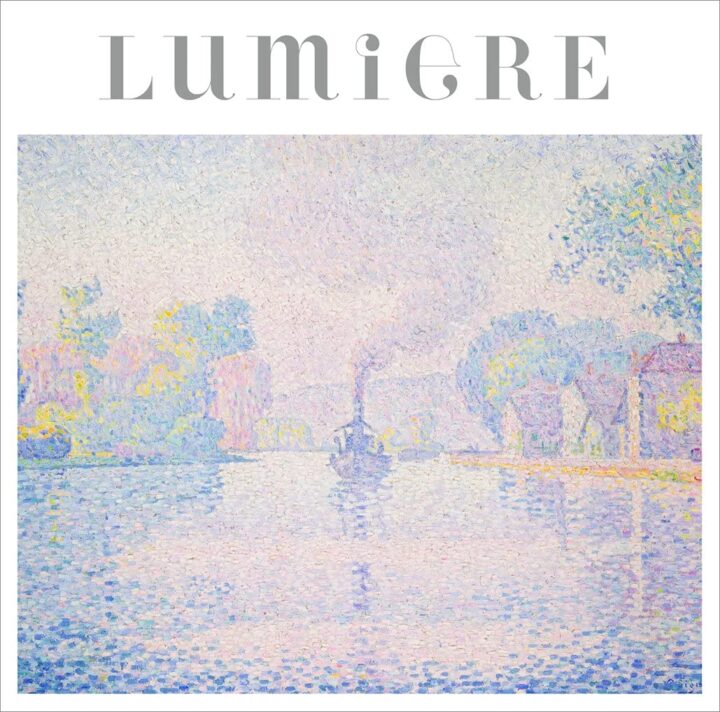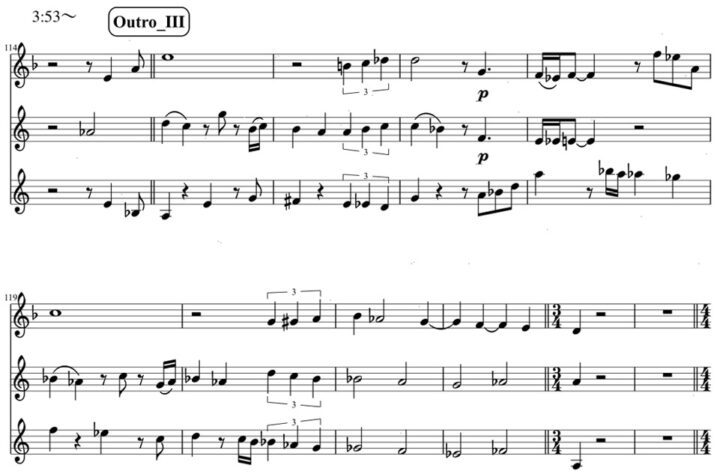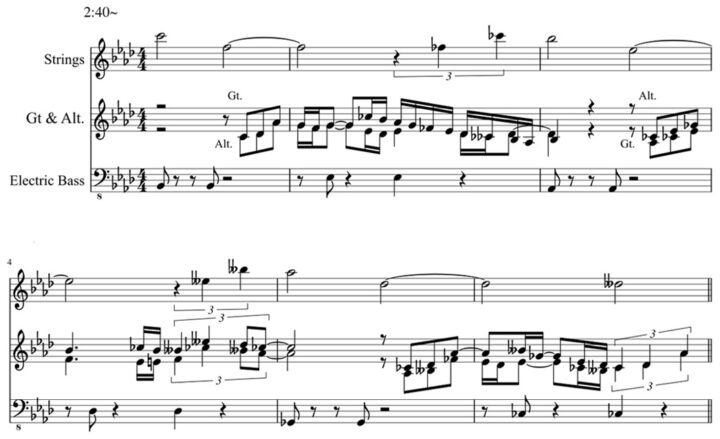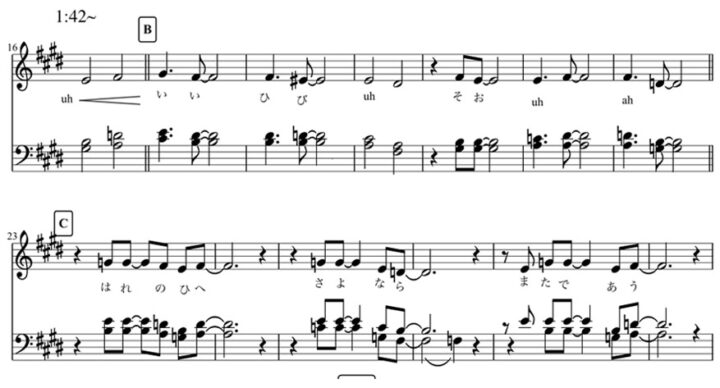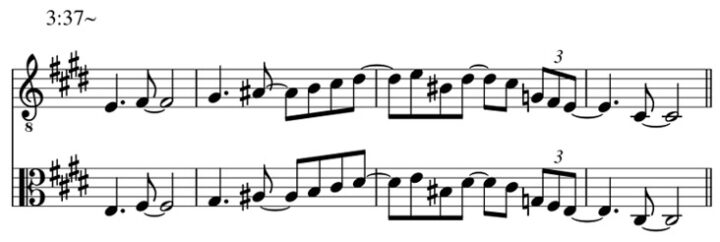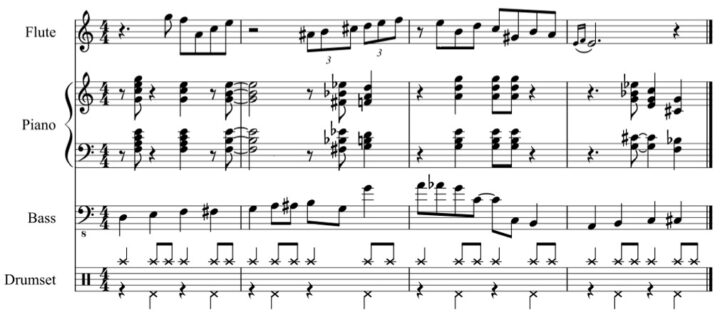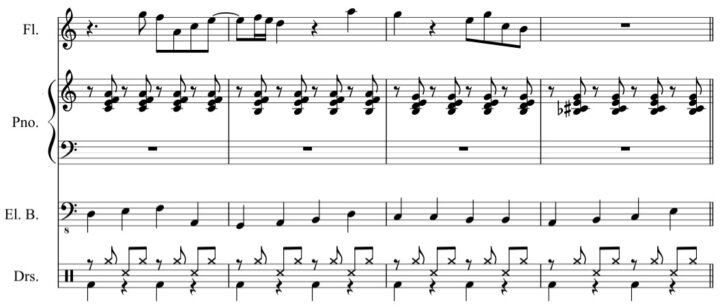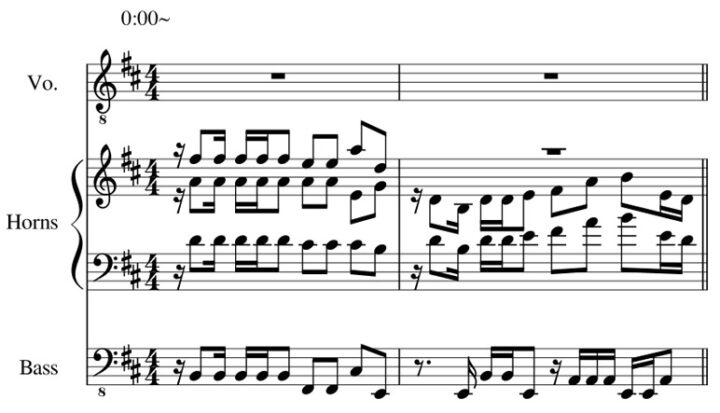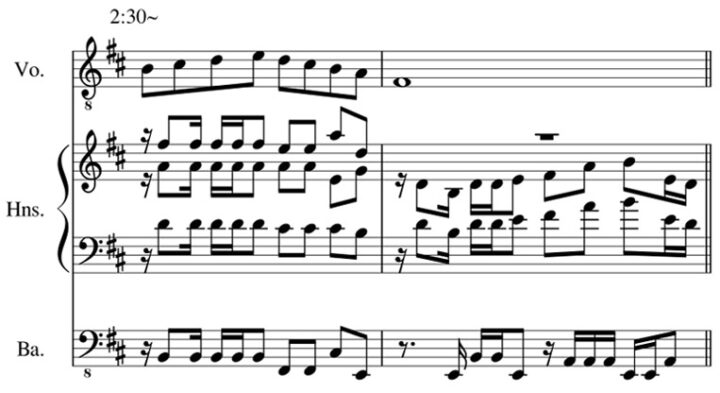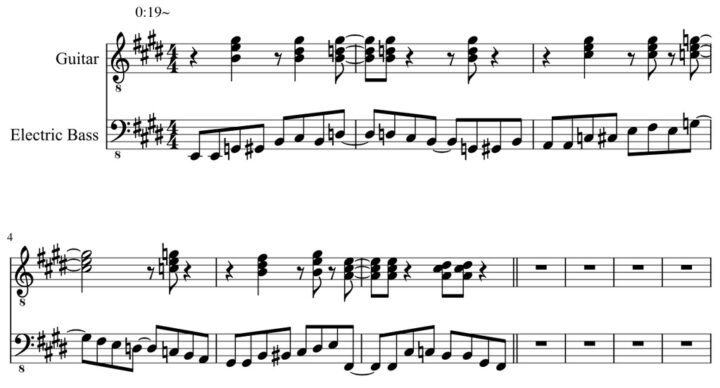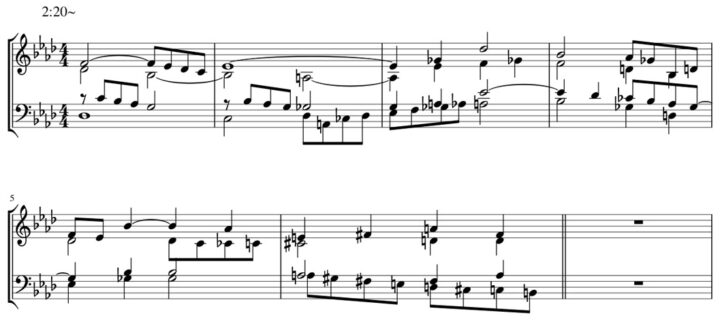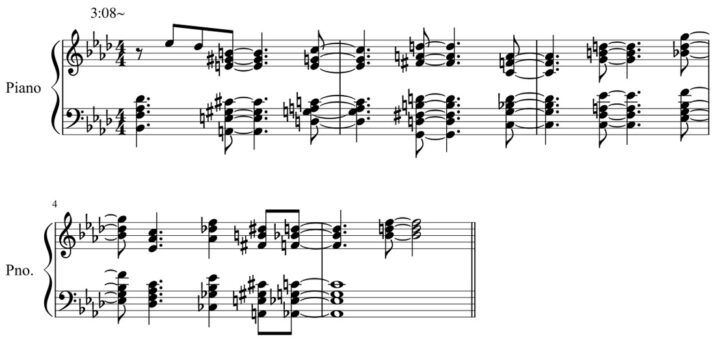Want to know more about Kitasono Minami and more specifically “part two” of his debut, lumiere? If so, you’ve certainly come to the right place. Enjoy!
Interview & text: Kato Naoko (Japanese text)
English translation: Henkka
Kitasono Minami on the web: Website, Blog, Twitter, SoundCloud
Note: You can buy lumiere from CDJapan.
Interview
Following his initial popularity on SoundCloud, this artist just released his first studio recordings on last year’s mini-album, promenade. On it, he wrote, composed, and arranged (including the orchestral arrangements of) all songs, and showcased his multi-instrumentalist abilities on the bass, guitar, and various other instruments. Kitasono Minami has been displaying immense talent and competency on his recorded material.
At the young age of just 24, his pop sound incorporating strings and horn sections is so beautiful, mellow, and most of all accessible that it is almost frightening. His second release, lumiere, only strengthens that feeling. Framed as the counterpart to promenade as its “twin mini-album,” this release gives the impression of possessing even more sounds which were not present on the previous release.
We conducted an email interview with the artist himself in regards to lumiere.
— Since lumiere acts as a counterpart to promenade, I wanted to ask: which parts of it especially do you find to be in contrast to the previous release?
Kitasono Minami: While I didn’t feel that it necessarily had to be a mini-album, I did want it to have some kind of a creative meaning. So when I decided I wanted lumiere to have a kind of “gorgeousness” to it, that’s probably what resulted in this kind of contrast between light and dark. I first had the idea after I’d finished making my first mini-album.
— But lumiere, like your first release, is also full of seemingly bright numbers. So the light/dark contrast isn’t in regards to the songs themselves, right?
Kitasono: It’s mostly the feel of the mixing where you might notice the most difference. Using promenade as a point of reference, I tried to make this release sound light, clear, and hi-fi.
As for the compositions themselves, since I personally admire works that are generally considered “cheerful,” I tried to make them come across that way. Despite it turning out how it did, my intention was to make this release much more joyful than my first one.
— It definitely sounds joyful! I wanted to ask you specifically about the songs. Much like “Soft Pop,” the opener on promenade, this release similarly starts with the orchestral sounds of “Yuugiri.” With the many modulations the song feels like it’s telling a story through its sound. It’s so enjoyable to listen to. What kinds of things were you conscious of when making this song?
Kitasono: The theme with this one was employing the dynamics of music to the fullest — it might be those undulations and modulations that suggest at a story. As for my sentiments towards the song, I wrote it with the hopes that it would be almost like a sort of bridge to my future work. It incorporates my wish to make the kinds of music that haven’t been made yet.
— I see, so it’s a song expressing your convictions about the future.
Kitasono: Also, I arranged all parts of “Yuugiri” on a score. I had avoided doing so up until this point on the account that it seemed like too much work, but this time around my objective was to find out how to do it, and what effect it would have if I did so. I did it in a way where each instrument played a minimal role, trying to make it as close to my music as possible.
— Wow… That’s amazing. Going forward, is it your objective to make your music take shape by your own hand to the extent that it’s possible?
Kitasono: Rather than “by my own hand” per se, my goal is more trying to make music exactly the way I envision it. I do believe it’s also important to have collaborators who you can trust musically.
— Like on “Tsugumi,” which is seemingly reminiscent of US roots music what with all the mandolin and banjo, or the backbeat-heavy, reggae-flavored “Atarashii Machi,” there are all kinds of different musical elements in your songs. However, none of the songs stick to any one genre in particular. Instead, they all have a sound that is very much “Kitasono Minami,” giving the work a sense of unity.
Kitasono: When I’m employing rhythms that are already well-known from any particular style, I feel like I’m reaping the benefits of music of the past. But as the actual spirit of the genre isn’t there, that allows me to play around with it in different ways while still maybe giving it a certain likeness to that particular genre. But then that’s all it is — a likeness. I feel guilty doing that kind of thing.
— Guilty? But it’s so good! By the way, another thing I find refreshing about “Atarashii Machi” is the dubby processing applied in the middle. What was your image of this song as you were making it?
Kitasono: I’d actually forgotten all about this, but I was originally planning on releasing lumiere back in April. Since that’s when I assumed it would be released, I was thinking about that feeling of when you’ve just arrived at a new city that is still totally unknown to you… That feeling when everything is new, and yet you just know how eventually you’ll be looking back on it all with nostalgia. But then what’s casting a shadow on those feelings is this sense of physical weariness… To me that sound of a dub-processed, high-pitch snare resonates with that feeling.
In this song, I achieved that with the sound of me hitting a table to which I then added delay and distortion. I remember back in elementary school hearing this song that suddenly introduced that sort of dub processing in it, and there was just something so nostalgic and uneasy about how it sounded. I still vividly remember that moment.
— To think that was the sound of you hitting a table…! It’s interesting to hear how those dub elements were linked to your personal feelings and how you made use of them. Towards the end of the album there are even more songs that make for rewarding listening. The progression in “Riff Rock” is amazing, featuring rhythm changes, phrases reminiscent of tango, and even a fusion-esque guitar solo. I was shocked to hear a song that could even accommodate such a potpourri of different elements.
Kitasono: I wrote the verse while playing an unplugged electric guitar and singing so quietly that only I could hear myself. While I think it’s good to sing the songs as you’re writing them, I don’t actually get to do that very often, and so in that sense that one is quite special among the verses on lumiere. I have a particular fondness of Piazzolla (Astor Piazzolla, noted Argentinian composer and bandoneon player) and so I’ve tried to mimic him. People who have listened to his material a bunch will probably notice some similarities.
In the initial stages of writing this song I had a feeling it would probably serve as a kind of an intermezzo, so I just threw in all kinds of favorite elements of mine. As a result, you’ll hear hints of things like tango and fusion in there. In terms of tone, I used digital synths and something I’ve been using ever since Windows 98: this thing called MSGS (Microsoft GS Wavetable SW Synth) which has a very cheap sound to it.
— Your lyrics, while simple and few in words, contain many different emotions. They have a very graceful kind of warmth about them. I especially feel that in “Riff Rock,” and while some of that is surely because of your gentle singing voice, is there anything you are especially conscious of when writing lyrics?
Kitasono: I’m always trying to write my lyrics as if there was no one there in the backdrop. I try to avoid phrasings that might be too distinctive, instead using only commonplace words and expressions. I don’t have any personal statement to make… It’s kind of just like these states that everyone goes through in life. Usually I’ll come up with some fragments of words when I’m composing, and then I just write the lyrics based on those fragments. It always feels like I’m playing a word association game.
For that song, I remember writing the lyrics the same day I recorded the vocals, drinking wine out of a teacup before going into the studio.
— So the lyrics reflect exactly what you were doing as you were writing them! I almost feel like I know you now. (laughs) The last track on the album, the big band song “Midnight Blue,” is a duet with Maika Loubté who was also featured on your last release.
Kitasono: When I’m working on an album, I’m especially thinking about the role that the arrangement of each song should play. I was asking myself whether that song was an indispensable key song in terms of the album as a whole or if it was more just a transitional, decorative type of song, and also about the character it had compared to the other songs. I decided that “Midnight Blue” needed to be a duet in order to highlight the cohesiveness of the album as a whole.
Maika Loubté’s voice gives an impression of being both delicate yet strong. On the song “Vitamin” from my last release, she was what gave the song the kind of character I wanted it to have, and on this song she once again fulfilled my expectations.
— Big band arrangements obviously being one of your fortes, how was it working with Igarashi Makoto and his group, IGA-BANG BB?
Kitasono: He gave me lots of guidance as to playing and recording which can be heard in the songs. I really gained a lot of insight during these recordings.
— A moment ago you were talking about the “roles” of each song. Just as was the case on your previous release, I feel like the instrumentation and tone of each song has something about it that the others don’t.
Kitasono: Thinking about the instrumentation in my songs… While I have some idea about what is generally considered to sound “lame” in music, judging by those standards I reckon I do have bad taste in some ways. There’s things in there I feel I can’t hear in other music, and that feeling has only been getting stronger. Sometimes I do empathize with other people’s work and I’ll try adopting their ideas — sometimes taking it too far.
Exploring the “principles” is something I always grapple with in my music. I’m always thinking about how I’d like to one day discover a method of making music that goes beyond “direct” and “simple.”
— “Principles” — what do you mean by that?
Kitasono: The ways in which an original piece of music bestows musical value to its sound and silence — those are the principles. I think of it as clues to all the various elements of music (melody, harmony, rhythm), and just fundamentally how to go about creating when it comes to those elements.
— I see… While some of the personnel — such as Sakata Manabu on drums — were already featured on your previous release, other artists are making their first appearance on this one. Did you do anything differently when working with the guest musicians?
Kitasono: After recording in the studio with the participating musicians, I would then record on top of their parts at home. One thing I was especially focused on was trying to play in parallel to what had been already recorded in studio.
— Now that you have released promenade and lumiere, it feels like you have in a way completed your debut work. Have these two releases given you any sort of a vision for what you might be doing in the future?
Kitasono: Working on my releases, I always seem to run into much more hardship than I’d anticipated beforehand. I’m always just trying to stop myself from giving up. But now that music has become a part of my daily routine, I no longer question myself when it comes to composing and arranging, and in a way that makes me feel more at ease. I’m going to think of what I do next as an extension to what I’ve done so far, and I hope I can remain feeling creative about music.
As for the near future, I have some vague ideas for three or so upcoming releases, so that’s something I’m looking forward to doing.
— Please don’t give up, and please do keep making music! Is there anything you’re looking to challenge yourself with in regards to those near future releases you mentioned?
Kitasono: I’ve always had to hold back on the parts that I play myself, but with the release I’m writing right now I’ve tried to get around that limiting factor… And the way I’m planning on doing so is with the help of even more additional musicians.
— That ties into what you were talking about at the beginning of our interview — you’re going to work with people who can help actualize the sounds that you envision. Finally, I just wanted to say on a personal note that I would love to see you perform live with a full band! Do you have any plans to do so at this point?
Kitasono: I don’t plan on performing on stage for at least the next five years. I have thought about doing a show with like ten front men so no one would know which one was actually me.
Liner Notes
Secondly, here are the liner notes for all songs as written by Kitasono himself. It can get quite technical at times — some of this stuff goes right over my head as I know nothing about music theory — but I’m hoping it will be insightful to the more musically knowledgeable readers.
Text: Kitasono Minami (Japanese text)
English translation: Henkka

I’m going to start by giving some general thoughts on the songs, followed by more detailed explanations using sheet music. As it is like a collection of short columns, you can start reading from wherever you like or you can just skim through it as you please.
Do try listening to lumiere as you read along.
“Yuugiri”
I was initially writing this song with Piazzolla in mind when I was suddenly reminded of historical period dramas and their music. That’s where I got the idea that in the parts where I had been planning on using an open snare, I would instead use a shime-daiko drum.
There are a two different types of shime-daiko: ones that are made mainly from wood and fastened with strings, and ones with metal frames and bolts. In this instance I used the latter. When you mic it, it blends in perfectly with the ensemble of Western instruments while still retaining a tone that has a uniquely Japanese ambiance to it.
I suppose my earlier reluctance to using traditional Japanese instruments or ethnic instruments in pop was because I was worried it might give it a feel of being too “eccentric,” which would then make the song sound insincere. My current objective is to mix together instruments of varying different musical styles in a natural way, and I feel like with this recording I’m a step closer to doing so, making them sound almost as if they originated from the same style to begin with.
● Three Saxophones
Baritone, alto, soprano — three saxophone parts, all arranged to sound somewhat independent of one another.
My attachment to the saxophone as an instrument has roots in my personal musical history as a member of our saxophone ensemble in junior high school. Naturally, given the history of the saxophone, most of the music we performed were French pieces from the early 20th century. These included some avant-garde works, too, which was all very new to me at the time.
A particular favorite of mine was the final movement of Desenclos’ quartet in which the harmonies are constantly changing, never indicating any clear direction. To put it another way, it strongly hints at any and all kinds of possibilities through its rich tapestry of sound. I believe I perceived it to be music that was at the same time both gorgeous and uncomfortable. In that respect it gave me an impression similar to that of jazz, giving it a sense of familiarity. Indeed, most modern jazz is heavily influenced by contemporary French music.
It was from that point on that I began to have an admiration for music with intricate structures giving it an elegance, and it was the tone of the saxophone which first introduced me to this type of music. I still held that same ideal with this work.
● The Fun Bit in the Outro
In the outro, you can hear a kind of a joke involving the saxophone trio. Accompanied in the background only by an old rhythm machine, it’s a far cry from the seriousness of the song’s first half.
Each of the three saxes is layered with a different instrument, creating a unique effect in terms of timbre. The soprano is paired with a full acoustic guitar, the alto with female vocals, and the baritone with an electric bass.
● Interlude Melody Duet
Both parts are equal — there’s give-and-take as both melodies avoid undesired contact with one another, resulting in the two melodies coming together as one presence.
“Tsugumi”
The tentative title for this one was “Country.” I wanted to write a song featuring lots of plucked string instruments, and so I got started by collecting all different kinds. I tried to combine acoustic guitar, mandolin, banjo, and ukulele in a reserved way so as to make them sound like they were one instrument.
In order to give the song an intimate atmosphere I had to be careful in choosing my “supporting actors” — that is, the soft flugelhorn and the viola full of subtle ambiguity. Had I instead used a trumpet and a violin, they would’ve given the song a different kind of flashiness. Also, the drumming was performed using rutes (drum sticks made from several thin wood or bamboo sticks that are bundled together), giving the song an unembellished feel.
● Backing Vocals
The bridge leading up to the chorus features three male backing voices. That is the minimum number of people required to achieve this kind of effect. I could’ve used four or five voices instead, but that might then have thrown it off balance. Reducing the number of voices gave it a lighter, more resonant finish. It also made things somewhat easier in recording, too.
Also, there are these moments when the backing vocals are playing in unison with other instruments…
● Mandolin + Female Backing Vocals (Combining Contrastive Timbres)
Here, you find a combination of the mandolin and female vocals — the arrangement’s core and its support, respectively.
Talking about the characteristics of their tones, while it may at first seem like the mandolin stands out more, as time passes it rather starts to sound like the sustained backing vocals are covering for the start/stop sounds of the mandolin. As such, neither instrument is more conspicuous than the other — they give an impression of being very equal. Also, the tremolo playing of the mandolin gives it a good balance.
While keeping in mind the commonly held views on the singing register and technique of female backing vocals, I had them play a role in a part of the melody. This sort of thing is doable when it contrasts with the main part of the arrangement.
● Viola + Male Backing Vocals (Combining Similar Timbres)
Like using two tones to create one. This melody appears twice during the song — in the interlude and in the outro — but this combination is only used in the outro. It provides a slight change, helping to avoid a feeling of repetition-induced boredom.
“Atarashii Machi”
Having heard stories about how ska was originally born through a series of misunderstandings when Jamaican musicians heard jazz on North American radio broadcasts, the stories aren’t totally unbelievable when one imagines the kind of sound systems they must’ve been using in those days.
Maybe to them, music like this…
…Sounded like this:
Well, maybe that’s a bit forced…
Still, in my experience, in fast four-beat rhythms the hi-hat pedal can feel like it’s quarter notes on the upbeat, and the root chords of bass lines placed on the downbeat can overshadow the notes on the following upbeat. These sorts of things can definitely happen quite spontaneously. Perhaps ska was indeed music born from jazz being simplified.
Wanting to create something like my own version of reggae, I tried to go beyond things like early ska music, reggae, and ska-core, focusing instead on the background of ska — predecessor of reggae — and the different styles of music derived from it.
Adding my own little twist to the rhythm, I used this large drum called “bombo” together with the snare.
Bombo is an instrument used to play the low tones in the rhythms of South American folklore music. The instrument itself is around the size of a small bass drum but lighter in weight, being performed as it hangs from the performer’s body.
● Repeating Horn Section Melody
Below is the intro part. The horn section carries the main melody.
As it goes into the chorus, what was previously the main melody in the intro now becomes the background for the vocals.
For people hearing it for the first time, it’s an all-new melody mixed with a melody they will have already heard earlier. Here, the vocal is the main subject and the melody in the background only plays a supporting role.
“Riff Rock”
It’s riff rock that I composed starting with the riff.
With the synths, I shamelessly mixed digital and analog, even bringing in some MSGS, which is what the weird bit in the interlude was played on. Not all music has to be made with studio equipment, sounding all high-end — that much is only obvious when you listen to all the different ways of production and expression employed by musicians today. But MSGS might be a different story… As one might expect, it gives the song a very out-of-place, surreal feel.
● The Riff
In addition to being being played on an electric bass with a pick, the bass line shown in the score below is also played with electric and acoustic guitars. As the harmonizing instruments are for the most part not playing the root notes, they are thus quite easily influenced by the melodious movements of the bass, leading to very fluid chord changes.
“Midnight Blue”
This is perhaps my third big band piece, and the first one to be released that was actually performed by live musicians.
The saxophone part was played by four saxists, which is fewer than the norm. Wanting to create somewhat of a noisy feel on this piece, I had the rhythm section playing chords, added some decorative instruments, and used two guitars and one keyboard. To then make the sound somewhat clearer to compensate, I opted to make it a bit of a lighter big band which is what led me to this configuration.
I only thought of using an FM synth electric piano after we’d finished recording the big band. I had initially planned on using either the Rhodes or a piano, but after doing what pop musicians do best — that is, trying out a whole bunch of stuff as the song is playing — the electric piano just seemed like it was the best fit.
In the 80’s, you began to hear FM and digital synths in the sounds of big bands involving first-class arrangers such as Bob Mintzer and Joe Zawinul. Also around this time, Frank Zappa and his jazz combo created unique moods using this very light sort of digital synth organ. Today, that kind of sound has long been considered to be in bad taste. Every now and then someone might still get the idea of trying it out of curiosity, but surely it’s an idea that is usually just quickly dismissed with a laugh.
● Interlude Sax Quartet
In the interlude, one can hear a simple sax quartet against the backdrop of vocals.
This sort of an arrangement needs to be done with a limited number of voices. Naturally, it’s easier to make it effective when there are fewer instruments involved. Above is a part of the score for reference. There’s a bit of imitation happening (here, it’s the bit that almost sounds like it’s chasing after the next), and those different inner voicings and melodies bring about some subtle changes in the sound.
● The Outro Sound
The “Upper Structure Triad” (or “UST”) is a chord structure made up of a triad’s upper part, and the lower part which is unregulated in regards to its construction. I like to use it in the following way:
The upper and lower parts are both in dominant motion (dissonance moving towards resolution). It’s also possible for it to keep forever seeking resolution, going from one dissonant note to the next in perpetuity.
In the outro of this song, you can hear the UST being used in this way:
To make the best use of UST in an arrangement, it’s preferable for the upper and lower parts to be given contrasting timbres. In this song, the upper part goes to the trumpet while the lower part is left to the trombone and the saxophone.
Furthermore, as long as you decide on a main timbre for the upper and lower parts, you could even do something like arranging the saxophone somewhere in between the trumpet and the trombone, for instance, and you would still get the intended effect. This is why with big band arrangements you should be relatively free to arrange all instrumentation — aside from the wind instruments — in whichever fashion you like.
